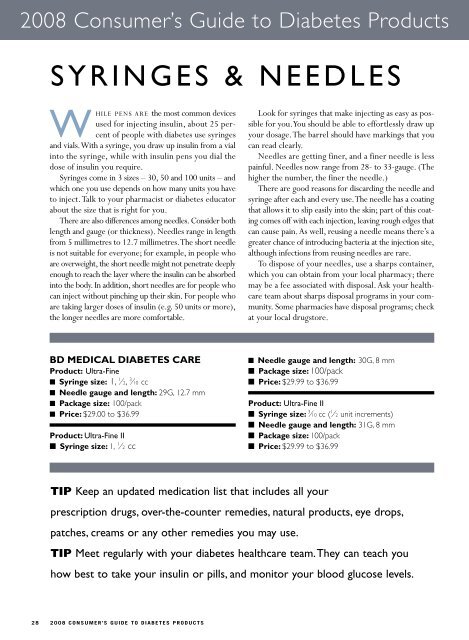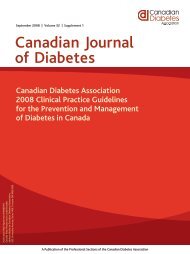Product listings Purchasing considerations Warranty information ...
Product listings Purchasing considerations Warranty information ...
Product listings Purchasing considerations Warranty information ...
You also want an ePaper? Increase the reach of your titles
YUMPU automatically turns print PDFs into web optimized ePapers that Google loves.
2008 Consumer’s Guide to Diabetes <strong>Product</strong>s<br />
SYRINGES & NEEDLES<br />
WHILE PENS ARE the most common devices<br />
used for injecting insulin, about 25 percent<br />
of people with diabetes use syringes<br />
and vials.With a syringe, you draw up insulin from a vial<br />
into the syringe, while with insulin pens you dial the<br />
dose of insulin you require.<br />
Syringes come in 3 sizes – 30, 50 and 100 units – and<br />
which one you use depends on how many units you have<br />
to inject.Talk to your pharmacist or diabetes educator<br />
about the size that is right for you.<br />
There are also differences among needles. Consider both<br />
length and gauge (or thickness). Needles range in length<br />
from 5 millimetres to 12.7 millimetres.The short needle<br />
is not suitable for everyone; for example, in people who<br />
are overweight, the short needle might not penetrate deeply<br />
enough to reach the layer where the insulin can be absorbed<br />
into the body. In addition, short needles are for people who<br />
can inject without pinching up their skin. For people who<br />
are taking larger doses of insulin (e.g. 50 units or more),<br />
the longer needles are more comfortable.<br />
BD MEDICAL DIABETES CARE<br />
<strong>Product</strong>: Ultra-Fine<br />
■ Syringe size: 1, 1 ⁄ 2, 3 ⁄10 cc<br />
■ Needle gauge and length: 29G, 12.7 mm<br />
■ Package size: 100/pack<br />
■ Price: $29.00 to $36.99<br />
<strong>Product</strong>: Ultra-Fine II<br />
■ Syringe size: 1, 1 ⁄ 2 cc<br />
28 2008 CONSUMER’S GUIDE TO DIABETES PRODUCTS<br />
Look for syringes that make injecting as easy as possible<br />
for you.You should be able to effortlessly draw up<br />
your dosage.The barrel should have markings that you<br />
can read clearly.<br />
Needles are getting finer, and a finer needle is less<br />
painful. Needles now range from 28- to 33-gauge. (The<br />
higher the number, the finer the needle.)<br />
There are good reasons for discarding the needle and<br />
syringe after each and every use.The needle has a coating<br />
that allows it to slip easily into the skin; part of this coating<br />
comes off with each injection, leaving rough edges that<br />
can cause pain.As well, reusing a needle means there’s a<br />
greater chance of introducing bacteria at the injection site,<br />
although infections from reusing needles are rare.<br />
To dispose of your needles, use a sharps container,<br />
which you can obtain from your local pharmacy; there<br />
may be a fee associated with disposal. Ask your healthcare<br />
team about sharps disposal programs in your community.<br />
Some pharmacies have disposal programs; check<br />
at your local drugstore.<br />
■ Needle gauge and length: 30G, 8 mm<br />
■ Package size: 100/pack<br />
■ Price: $29.99 to $36.99<br />
<strong>Product</strong>: Ultra-Fine II<br />
■ Syringe size: 3 ⁄10 cc ( 1 ⁄ 2 unit increments)<br />
■ Needle gauge and length: 31G, 8 mm<br />
■ Package size: 100/pack<br />
■ Price: $29.99 to $36.99<br />
TIP Keep an updated medication list that includes all your<br />
prescription drugs, over-the-counter remedies, natural products, eye drops,<br />
patches, creams or any other remedies you may use.<br />
TIP Meet regularly with your diabetes healthcare team.They can teach you<br />
how best to take your insulin or pills, and monitor your blood glucose levels.











